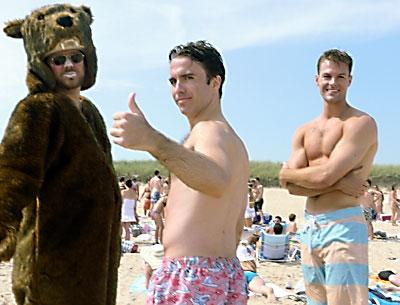Beach Barrier Considered to Deter Party Crowd

A potential solution to overcrowding and unchecked alcohol consumption at Indian Wells Beach that includes an attended booth at the intersection of Indian Wells Highway and Bluff Road may be implemented ahead of the summer season, the Amagansett Citizens Advisory Committee was told at its meeting on Monday.
East Hampton Town Councilwoman Sylvia Overby, who is the committee’s liaison to the town board, described to members a plan would have an attendant at the booth drag a barrier across Indian Wells Highway when the beach parking lot, which can hold 117 cars, becomes full. Taxis, buses, and all other vehicles except those bearing a resident or Amagansett Beach Association sticker would be prohibited from proceeding.
The intent is twofold. In addition to relieving congestion at the road end, at which taxis, buses, and private vehicles are typically dropping off and picking up passengers, or idling while awaiting an available parking space, it is hoped that forcing beachgoers to walk from the Bluff Road intersection will discourage them from carrying coolers and kegs to the alcohol-fueled gatherings for which the beach has become known.
In addition, the junior lifeguard program would be moved forward by 30 minutes to a 9 a.m. start, allowing it to end at 11 a.m. instead of 11:30. This is expected to remove approximately 20 vehicles from the lot, just as it typically nears capacity.
The plan, Ms. Overby told the committee, “is very, very preliminary. The town is concerned, the board has gotten several letters. This is something we want to try to solve.” The plan, she said, was devised in meetings with officials including Supervisor Bill Wilkinson, East Hampton Town Police Chief Edward Ecker and Captain Michael Sarlo, Ed Michaels, the town harbormaster, John Rooney, the superintendent of recreation, John Ryan Jr., the town’s chief lifeguard, and Robert Connelly, an assistant town attorney.
To allow buses to turn around at the barrier, the intersection may need to be reconfigured, Ms. Overby said. Quoting Chief Ecker, she said, “This could be a start, but it may not be a finish.” A midsummer course correction could also happen, she said, should the plan prove problematic or ineffective — congestion might simply move from the road end to the Bluff Road intersection, for example, or the alcohol-imbibing crowds may move to Atlantic Avenue Beach. “Nobody is going to be completely happy. We can’t please everybody,” the councilwoman said, but “I don’t want to start the summer with nothing.”
Everyone agreed. “To do nothing is worse than doing something,” said John Broderick. “It’s going to be a work in progress. That’s a busy intersection all year, but something definitely has to be done.”
An expansion of the parking lot, perhaps stretching all the way to Bluff Road, is a project the town board may address next year, Ms. Overby said, though the land in question contains wetlands. In addition, new signs prohibiting parking on Further Court and Southview, nearby streets that have become popular parking hideaways for beachgoers, is likely, Ms. Overby said.
Tom Field proposed that the committee write to the board expressing its support for the pilot program described by Ms. Overby. Other members were unanimous in agreement.
Ms. Overby reported that the town board would discuss new taxi legislation at its work session the next day. The legislation remains a work in progress and the board will consider a revised version in the near future. “For me, the issue is safety,” she said, along with a requirement that fares be posted. “If you stand at Indian Wells and watch the kids pile into the cabs, it’s not safe, it’s illegal,” she said.
It’s less a quality-of-life issue than a safety issue, Mr. Broderick agreed. “It’s like the beach: There’s obviously something wrong if we’ve gotten to the point where we had to draft legislation and try and put it into law.”
Finally, Ms. Overby reported to the committee that she had marched in the Am O’Gansett parade on Saturday. “It’s bigger every year,” she said of the fifth annual event. “The kids were having a great time. It felt really good.”
It was also decided to include in the minutes of the meeting praise for Steve Lynch, the town highway superintendent, for exemplary work clearing roadways in the wake of winter’s substantial snowfall.
Lt. Tom Grenci of the town police will be invited to the board’s next meeting on April 8 to further discuss Indian Wells Beach and other police matters.
